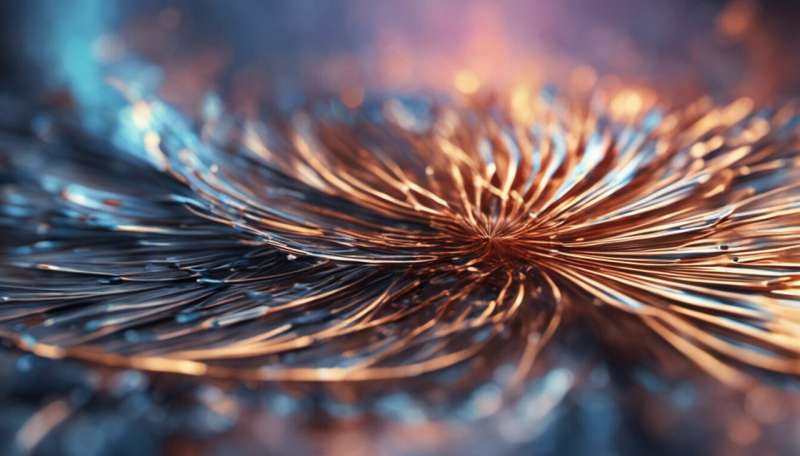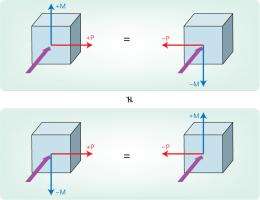Optics get magnetic powers

For decades, scientists have studied a class of materials called ‘multiferroics’ in which static electric and magnetic structures are coupled to each other. This allows capabilities such as controlling magnetic order with electric fields instead of magnetic ones, making it easier to build devices such as sensors and computer memory.
The dynamic equivalent of this static coupling, or the linking of the electric and magnetic fields of excitations inside materials, would expand these capabilities even further. However, observations of dynamic coupling have been rare and coupling strengths weak. Now, researchers in Japan have observed strong cross-coupling of dynamic excitations in multiferroic materials called rare-earth perovskites. The work has revealed optical properties in opto-electronic materials similar to those found in common dichroic glass (Fig.1), and may make possible new types of optical devices.
Control via coupling
At the microscopic level, the electric and magnetic field structures inside any material are complicated. Small displacements of electrons from their equilibrium positions cause electric polarization and create associated electric fields. Similarly, electrons have either a ‘spin up’ or ‘spin down’ magnetic configuration that can produce magnetic fields, or dipoles. These electric and magnetic fields can be aligned randomly, or they can form complex, large-area structures useful for devices, explains Youtarou Takahashi from the Japan Science and Technology Agency and the RIKEN Advanced Science Institute, who led the team that observed the dynamic cross-coupling.
The microscopic electric fields in ‘ferroelectric’ materials, for example, are organized into domains containing millions of atoms. The fields inside a single domain point in the same direction, which can be set with an externally applied electric field. Since information can be stored in the domain orientations, scientists are studying ferroelectrics as candidates for next-generation, ultra-high-density storage. Similarly, microscopic domains in ferromagnets align into domains that can be controlled with an external magnet.

In most devices made from ferroelectric and ferromagnetic materials, like controls like: electric fields control electric domains, and magnetic fields control magnetic domains. In multiferroics, however, electric fields control magnetic structures and vice versa. This is useful because magnetic fields are more difficult to create and control at small scales than electric fields. The ability to move beyond static cross-coupling, and link the electric and magnetic field components of a time-varying excitation, could yield additional capabilities, such as control over the absorption of light and its direction.
Getting excited
Takahashi, along with colleagues from the University of Tokyo and the RIKEN Advanced Science Institute, observed strong, dynamic coupling by studying how rare-earth perovskite materials absorb light at terahertz frequencies. The microscopic magnetic field components, called spins, in these materials arrange spontaneously into a helix. Because light consists of oscillating electric and magnetic fields, its absorption can distort the material’s atomic lattice.
Other researchers had previously observed that light absorption in rare-earth perovskites established a transient electric field that distorted the magnetic spin helix structure by modulating the interactions between neighboring spins. However, the reverse coupling did not exist—the magnetic distortion, or excitation, did not affect electric polarization—so the excitation was not mutually cross-coupled, Takahashi notes.
Takahashi and colleagues extended these results by changing the orientation of the incident light relative to the perovskite atomic lattice. They exploited the fact that rare-earth perovskites have an inherent electric field, or polarization, which results from a combination of their helical spin structure, and a ‘spin–orbit’ interaction that couples the orbital motion of electrons to electron spin. They found that, when they oriented the electric field of the incident light perpendicularly to the material’s inherent electric field, a truly cross-coupled excitation resulted.
This cross-coupling resulted from the fact that the perovskite’s inherent electric field was derived entirely from its helical spin structure: when it was affected by the light field, the spin structure was affected. And when the spin structure distorted, it in turn changed the electric field. The researchers confirmed the cross-coupled nature of the excitation by studying how absorption strength changed under different magnetic fields and varying incident light energy.
Switching backwards and forwards
Takahashi and his colleagues also demonstrated an immediate and remarkable consequence of this cross-coupled excitation: their rare-earth perovskite absorbed more of the light that passed through it in one direction than it did light passing through in the opposite direction. In a regular material, the absorption strength would be identical in each direction since only the strength of the electric polarization, internal to the material—not its direction—would affect absorption. When cross-coupling occurs, however, the directions of the absorbing material’s internal electric and magnetic fields also matter. Because reversing the direction of light travel reverses at least one of these internal field directions, absorption will vary for different directions of travel (Fig. 2).
This so-called ‘directional dichroism’ effect, reminiscent of dichroic glass, could have applications to efficient optical switching of terahertz light signals in high-speed communication switches and optical circuits. This and other applications may represent the beginning of a new field. “I think that this research marks the beginning of magneto-electric optics, which will be based on a firm understanding of the microscopic mechanisms in magneto-electric materials,” says Takahashi.
This nascent field will be helped, Takahashi continues, by the likelihood that cross-coupled excitations will turn out to be relatively common. Like the excitations observed here, they will probably be in the gigahertz-to-terahertz frequency regime, and will occur in materials that exhibit ferroelectric order derived from magnetic spin structure—possibly including many of the multiferroics that are already known to scientists.
More information: Takahashi, Y., et al. Magnetoelectric resonance with electromagnons in a perovskite helimagnet. Nature Physics published online, 4 December 2011 doi: 10.1038/NPHYS2161 .
Journal information: Nature Physics
Provided by RIKEN

















